Terminate redirects to and from the ousebutheches.pro website
Mac VirusAlso Known As: cousebutheches.pro pop-up
Get free scan and check if your device is infected.
Remove it nowTo use full-featured product, you have to purchase a license for Combo Cleaner. Seven days free trial available. Combo Cleaner is owned and operated by RCS LT, the parent company of PCRisk.com.
What is cousebutheches[.]pro?
cousebutheches[.]pro is a scam website that generates redirects and trick users into installing a third party (or fake) Flash Player update. These updaters are often used to proliferate PUAs (potentially unwanted applications) and even malware (malicious software).
Few visitors to cousebutheches[.]pro access it willingly. Most are redirected by intrusive advertisements or PUAs already present on the system. Note that unwanted apps do no need explicit user permission to infiltrate devices.
![cousebutheches[.]pro scam](/images/stories/screenshots201907/cousebuthechespro-homepage.jpg)
Once accessed, the cousebutheches[.]pro webpage states that users must enable browser notifications to begin downloading. If consent to notifications is given, the site starts running intrusive ad campaigns.
Ads of this type are deemed a threat, due to the untrustworthy and malicious websites they redirect to, and for their ability to execute scripts designed to stealthily download/install PUAs. Note that cousebutheches[.]pro also generates redirects. These lead to a site displaying a pop-up window proclaiming that Flash Player might be out-of-date.
It further states that the aforementioned software is missing the latest security updates and can no longer be used unless it is updated. The web page shows several buttons to download/update Flash Player. Do not trust these scam sites or download/install anything advertised.
Websites, such as cousebutheches[.]pro are known to use 'clickbait', which attracts attention by showing false messages (e.g. claiming they need to be clicked to access web pages, read or view something, receive prizes, provide protection from detected viruses, and so on).
Clickbait is often employed to hide intrusive advertisements, which pose the risks mentioned above. Furthermore, files downloaded from scam websites (e.g. the maccleaner.pkg file) can install unwanted applications or malware, rather than the content promised. The same extends to fake software updaters.
PUAs offer a wide range of features, however, they are mostly nonfunctional, regardless of any legitimate appearances. These apps can also ask users to purchase activation keys. I.e., buy the software (for example, Cleanup My Mac, MacOptimizer, Mac Cleanup Pro, etc.).
Once purchased, however, these programs remain nonoperational and unable to perform the features they advertise. Rather than delivering any real value, PUAs cause redirects to sale-based, untrustworthy, even malicious web pages, deliver intrusive ad campaigns, and track data.
By monitoring browsing activity, they can gather personal information (IP addresses, geolocations, and personal details). This private data is then sold to third parties and can end up being used for criminal purposes.
Therefore, PUAs can cause various browser and system infiltration/infections and lead to severe privacy issues (even identity theft). To ensure device and user safety, remove all suspicious applications and/or browser extensions/plug-ins immediately.
| Name | cousebutheches.pro pop-up |
| Threat Type | Mac malware, Mac virus. |
| Symptoms | Your Mac becomes slower than normal, you see unwanted pop-up ads, you are redirected to dubious websites. |
| Serving IP Address | 104.18.8.112 |
| Observed Domains | edmk.cousebutheches[.]pro, h69j.cousebutheches[.]pro, mftl.cousebutheches[.]pro, mgpe.cousebutheches[.]pro, p9c9.cousebutheches[.]pro, ryjy.cousebutheches[.]pro, uyv0.cousebutheches[.]pro |
| Distribution methods | Deceptive pop-up ads, free software installers (bundling), fake flash player installers, torrent file downloads. |
| Damage | Internet browser tracking (potential privacy issues), display of unwanted ads, redirects to dubious websites, loss of private information. |
| Malware Removal (Windows) |
To eliminate possible malware infections, scan your computer with legitimate antivirus software. Our security researchers recommend using Combo Cleaner. Download Combo CleanerTo use full-featured product, you have to purchase a license for Combo Cleaner. 7 days free trial available. Combo Cleaner is owned and operated by RCS LT, the parent company of PCRisk.com. |
There are thousands of scam sites online - apple.com-mac-optimizer.icu, macos-online-security-check.com, and apple.security-help-center.club are just a few websites similar to cousebutheches[.]pro. These sites usually promote various updaters and "practical" software.
They do so by warning about outdated programs, detected system infections, and using similar scare tactics. The advertised software is sometimes legitimate, yet pre-packed with unwanted/malicious content. For example, it can update preexisting programs and also install PUAs or malware.
Note that these websites are highly untrustworthy, and downloading/installing any content they endorse is not recommended.
How did potentially unwanted applications install on my computer?
PUAs and fake updaters can be downloaded from untrustworthy download sources. E.g. scam, unofficial or free file-hosting websites, Peer-to-Peer sharing networks (BitTorrent, eMule, Gnutella, etc.) and similar channels. Unwanted applications can also proliferate though the download/installation set-ups of other software.
The deceptive marketing tactic of packing ordinary programs with PUAs is called "bundling". By rushing through the download/install processes (ignoring terms, skipping steps, using pre-set options, and similar), users can inadvertently allow unwanted or malicious content into their systems. Intrusive advertisements are also known to spread PUAs.
Once clicked, they can execute scripts to make automatic downloads/installations of PUAs.
How to avoid installation of potentially unwanted applications
Use trustworthy and verified sources for downloading your content. Programs should be kept up-to-date via tools/functions provided by the official developer, and not those obtained from third parties. Exercise caution with download/installation processes.
Read the terms, use "Custom/Advanced" settings, and decline downloading/installing of supplementary apps, tools, features, etc. When browsing, avoid suspicious sites and ads. Intrusive advertisements usually seem legitimate and harmless, however, they often redirect to dubious sites (e.g. gambling, pornography, adult-dating, and similar).
If you encounter these ads/redirects, check your systems and immediately and remove all dubious applications and browser extensions/plug-ins. If your computer is already infected with PUAs, we recommend running a scan with Combo Cleaner Antivirus for Windows to automatically eliminate them .
Appearance of "cousebutheches[.]pro" scam (GIF):
![Appearance of cousebutheches[.]pro scam (GIF)](/images/stories/screenshots201907/cousebuthechespro-gif.gif)
IMPORTANT NOTE! This deceptive site asks to enable web browser notifications.
Therefore, before commencing, perform these steps:
Google Chrome (PC):
- Click the Menu button (three dots) on the right upper corner of the screen
- Select "Settings", scroll down to the bottom and click "Advanced"
- Scroll down to the "Privacy and security" section, select "Content settings" and then "Notifications"
- Click three dots on the right hand side of each suspicious URL and click "Block" or "Remove" (if you click "Remove" and visit the malicious site once more, it will ask to enable notifications again)
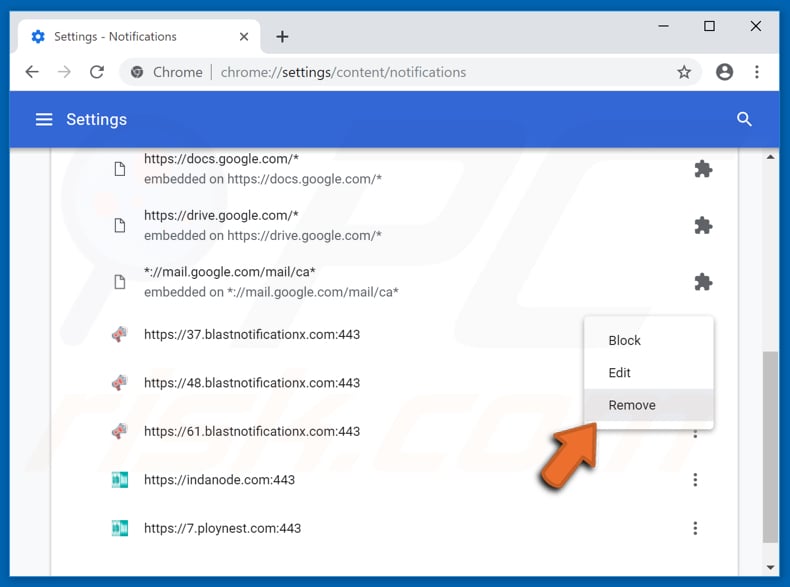
Google Chrome (Android):
- Click on the Menu button (three dots) on the right upper corner of the screen and click "Settings"
- Scroll down, click on "Site settings" and then "Notifications"
- In the opened window, locate all suspicious URLs and click on them one-by-one
- Select "Notifications" in the "Permissions" section and set the toggle button to "OFF"
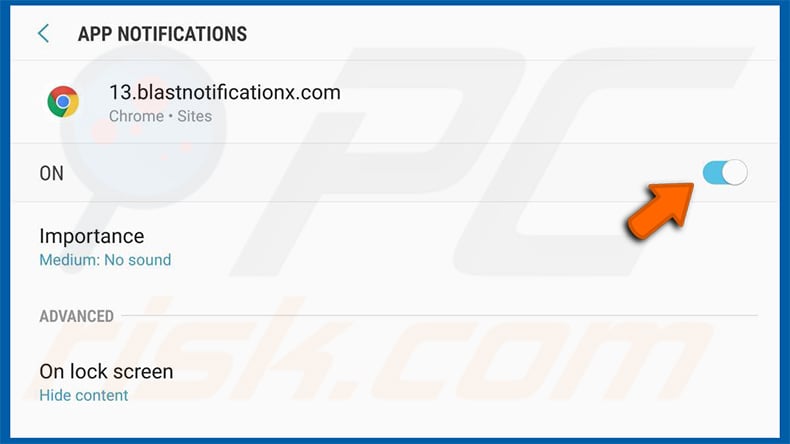
Mozilla Firefox:
- Click the Menu button (three bars) on the right upper corner of the screen
- Select "Options" and click on "Privacy & Security" in the toolbar on the left hand side of the screen
- Scroll down to the "Permissions" section and click the "Settings" button next to "Notifications"
- In the opened window, locate all suspicious URLs, click the drop-down menu and select "Block"
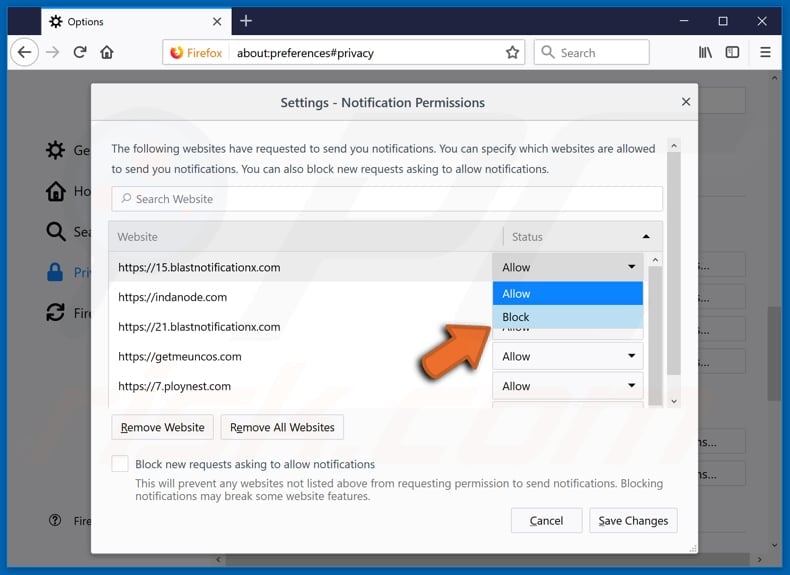
Internet Explorer:
- Click the Gear button on the right upper corner of the IE window
- Select "Internet options"
- Select the "Privacy" tab and click "Settings" under "Pop-up Blocker" section
- Select suspicious URLs under and remove them one by one by clicking the "Remove" button
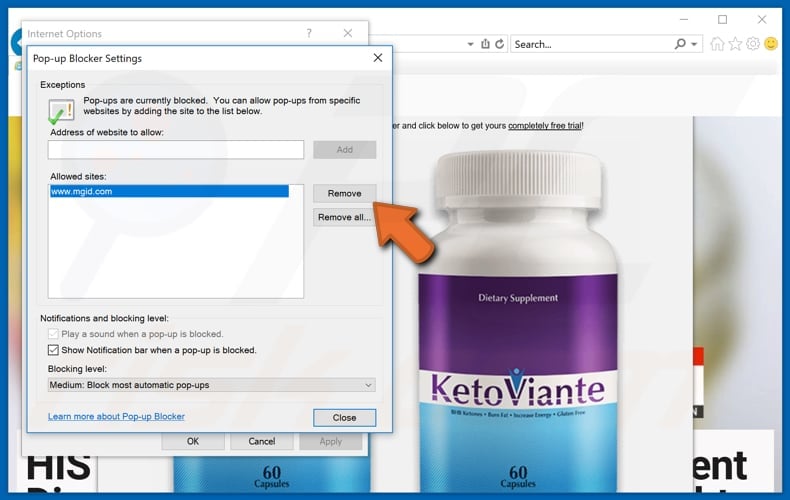
Microsoft Edge:
- Click the menu button (three dots) on the right upper corner of the Edge window
- Scroll down, find and click "Settings"
- Scroll down again and click "View advanced settings"
- Click "Manage" under "Website permissions"
- Click the switch under each suspicious website
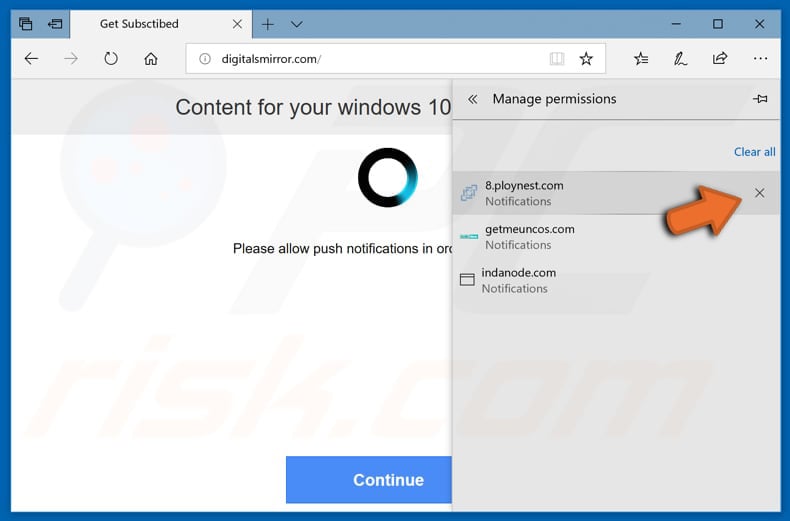
Safari (Mac):
- Click "Safari" button on the left upper corner of the screen and select "Preferences..."
- Select the "Websites" tab and then select "Notifications" section on the left pane
- Check for suspicious URLs and apply the "Deny" option for each
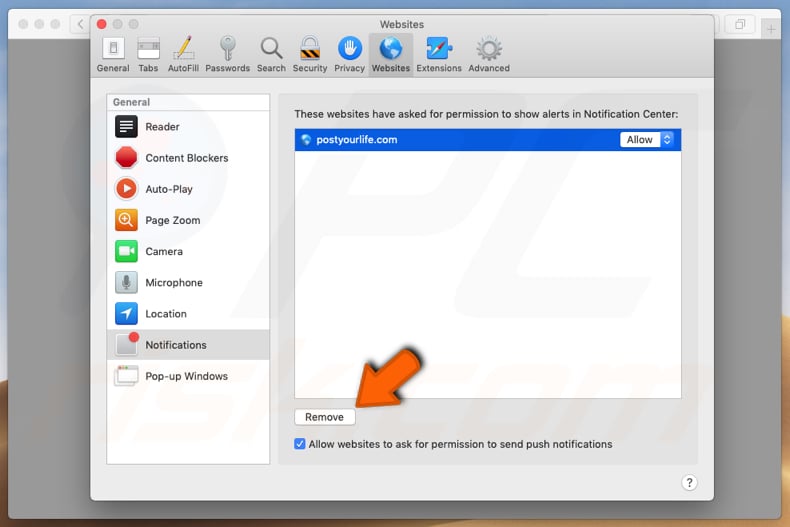
Instant automatic malware removal:
Manual threat removal might be a lengthy and complicated process that requires advanced IT skills. Combo Cleaner is a professional automatic malware removal tool that is recommended to get rid of malware. Download it by clicking the button below:
DOWNLOAD Combo CleanerBy downloading any software listed on this website you agree to our Privacy Policy and Terms of Use. To use full-featured product, you have to purchase a license for Combo Cleaner. 7 days free trial available. Combo Cleaner is owned and operated by RCS LT, the parent company of PCRisk.com.
Quick menu:
- What is "cousebutheches[.]pro"?
- STEP 1. Remove PUA related files and folders from OSX.
- STEP 2. Remove rogue extensions from Safari.
- STEP 3. Remove rogue add-ons from Google Chrome.
- STEP 4. Remove potentially unwanted plug-ins from Mozilla Firefox.
Video showing how to remove adware and browser hijackers from a Mac computer:
Potentially unwanted applications removal:
Remove potentially unwanted applications from your "Applications" folder:

Click the Finder icon. In the Finder window, select "Applications". In the applications folder, look for "MPlayerX","NicePlayer", or other suspicious applications and drag them to the Trash. After removing the potentially unwanted application(s) that cause online ads, scan your Mac for any remaining unwanted components.
DOWNLOAD remover for malware infections
Combo Cleaner checks if your computer is infected with malware. To use full-featured product, you have to purchase a license for Combo Cleaner. 7 days free trial available. Combo Cleaner is owned and operated by RCS LT, the parent company of PCRisk.com.
Remove adware-related files and folders

Click the Finder icon, from the menu bar. Choose Go, and click Go to Folder...
 Check for adware generated files in the /Library/LaunchAgents/ folder:
Check for adware generated files in the /Library/LaunchAgents/ folder:

In the Go to Folder... bar, type: /Library/LaunchAgents/

In the "LaunchAgents" folder, look for any recently-added suspicious files and move them to the Trash. Examples of files generated by adware - "installmac.AppRemoval.plist", "myppes.download.plist", "mykotlerino.ltvbit.plist", "kuklorest.update.plist", etc. Adware commonly installs several files with the exact same string.
 Check for adware generated files in the ~/Library/Application Support/ folder:
Check for adware generated files in the ~/Library/Application Support/ folder:

In the Go to Folder... bar, type: ~/Library/Application Support/

In the "Application Support" folder, look for any recently-added suspicious folders. For example, "MplayerX" or "NicePlayer", and move these folders to the Trash.
 Check for adware generated files in the ~/Library/LaunchAgents/ folder:
Check for adware generated files in the ~/Library/LaunchAgents/ folder:

In the Go to Folder... bar, type: ~/Library/LaunchAgents/

In the "LaunchAgents" folder, look for any recently-added suspicious files and move them to the Trash. Examples of files generated by adware - "installmac.AppRemoval.plist", "myppes.download.plist", "mykotlerino.ltvbit.plist", "kuklorest.update.plist", etc. Adware commonly installs several files with the exact same string.
 Check for adware generated files in the /Library/LaunchDaemons/ folder:
Check for adware generated files in the /Library/LaunchDaemons/ folder:

In the "Go to Folder..." bar, type: /Library/LaunchDaemons/

In the "LaunchDaemons" folder, look for recently-added suspicious files. For example "com.aoudad.net-preferences.plist", "com.myppes.net-preferences.plist", "com.kuklorest.net-preferences.plist", "com.avickUpd.plist", etc., and move them to the Trash.
 Scan your Mac with Combo Cleaner:
Scan your Mac with Combo Cleaner:
If you have followed all the steps correctly, your Mac should be clean of infections. To ensure your system is not infected, run a scan with Combo Cleaner Antivirus. Download it HERE. After downloading the file, double click combocleaner.dmg installer. In the opened window, drag and drop the Combo Cleaner icon on top of the Applications icon. Now open your launchpad and click on the Combo Cleaner icon. Wait until Combo Cleaner updates its virus definition database and click the "Start Combo Scan" button.

Combo Cleaner will scan your Mac for malware infections. If the antivirus scan displays "no threats found" - this means that you can continue with the removal guide; otherwise, it's recommended to remove any found infections before continuing.

After removing files and folders generated by the adware, continue to remove rogue extensions from your Internet browsers.
Remove malicious extensions from Internet browsers
 Remove malicious Safari extensions:
Remove malicious Safari extensions:

Open the Safari browser, from the menu bar, select "Safari" and click "Preferences...".

In the preferences window, select "Extensions" and look for any recently-installed suspicious extensions. When located, click the "Uninstall" button next to it/them. Note that you can safely uninstall all extensions from your Safari browser - none are crucial for regular browser operation.
- If you continue to have problems with browser redirects and unwanted advertisements - Reset Safari.
 Remove malicious extensions from Google Chrome:
Remove malicious extensions from Google Chrome:

Click the Chrome menu icon ![]() (at the top right corner of Google Chrome), select "More Tools" and click "Extensions". Locate all recently-installed suspicious extensions, select these entries and click "Remove".
(at the top right corner of Google Chrome), select "More Tools" and click "Extensions". Locate all recently-installed suspicious extensions, select these entries and click "Remove".

- If you continue to have problems with browser redirects and unwanted advertisements - Reset Google Chrome.
 Remove malicious extensions from Mozilla Firefox:
Remove malicious extensions from Mozilla Firefox:

Click the Firefox menu ![]() (at the top right corner of the main window) and select "Add-ons and themes". Click "Extensions", in the opened window locate all recently-installed suspicious extensions, click on the three dots and then click "Remove".
(at the top right corner of the main window) and select "Add-ons and themes". Click "Extensions", in the opened window locate all recently-installed suspicious extensions, click on the three dots and then click "Remove".

- If you continue to have problems with browser redirects and unwanted advertisements - Reset Mozilla Firefox.
Share:

Tomas Meskauskas
Expert security researcher, professional malware analyst
I am passionate about computer security and technology. I have an experience of over 10 years working in various companies related to computer technical issue solving and Internet security. I have been working as an author and editor for pcrisk.com since 2010. Follow me on Twitter and LinkedIn to stay informed about the latest online security threats.
PCrisk security portal is brought by a company RCS LT.
Joined forces of security researchers help educate computer users about the latest online security threats. More information about the company RCS LT.
Our malware removal guides are free. However, if you want to support us you can send us a donation.
DonatePCrisk security portal is brought by a company RCS LT.
Joined forces of security researchers help educate computer users about the latest online security threats. More information about the company RCS LT.
Our malware removal guides are free. However, if you want to support us you can send us a donation.
Donate
▼ Show Discussion